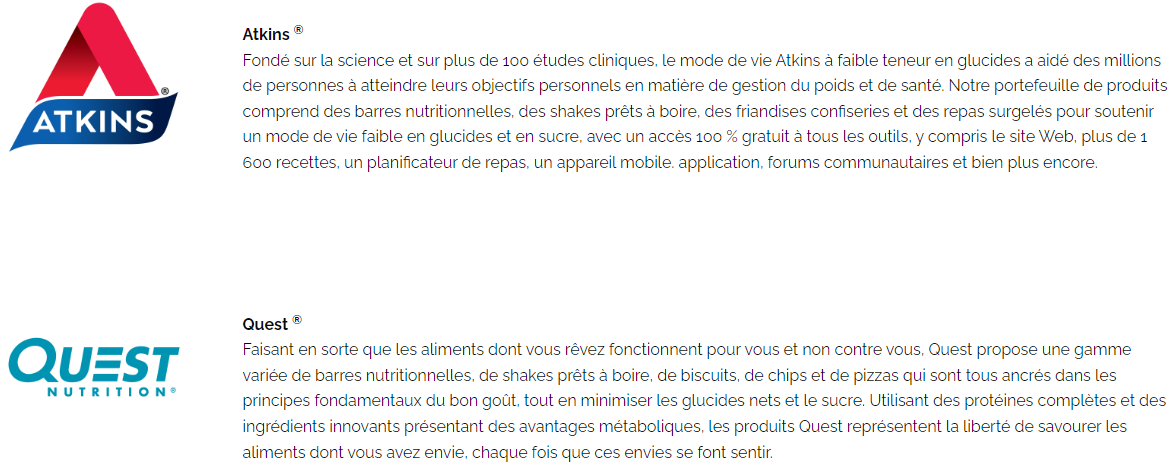The Simply Good Foods Company, which we'll abbreviate TSGFC for the sake of brevity, has made a name for itself in just a few years. The specialist of high-protein, low-sugar foods and beverages was founded in 2016, and started out as a SPAC. In July 2016, it acquired its first brand, Atkins, followed by Quest in November 2019. Beyond the products sold, Atkins is also known for the "Atkins diet", which was originally proposed by the doctor of the same name. This program aims to help customers achieve their weight-loss goals, and enjoys great popularity in the United States, where TSGFC does most of its business. International sales represent only a tiny fraction (2.9% of revenues), mainly concentrated in Australia and New Zealand.
The group's two brands: Atkins and Quest (source: The Simply Good Foods Company)

The "healthy" trend makes the Group happy
The trend towards low-carb, high-protein products extends far beyond the gym. This culture of healthy eating mainly concerns a young clientele, aged between 18 and 35, looking for a diet that meets three criteria: tasty, healthy and practical. As a result, snacks and meal replacements have found their way into backpacks and kitchen cupboards. However, the success of these products would probably not be as marked without a particularly effective marketing strategy. This young clientele is connected and easy to target thanks to modern technologies. TSGFC uses social networks and collaborates with influencers. The company invests heavily in advertising, sample distribution and participation in various events. Not surprisingly, marketing expenditure is substantial. In 2022, they represented 10.4% of sales, and even 11.2% in 2021.
A small selection of Atkins products (source: The Simply Good Foods Company)

A well-built model
In general, it's difficult for new brands to establish themselves in such a competitive market. Customer expectations are high, and acquiring market share proves complicated. TSGFC is a relatively young company, but its two brands already enjoyed a solid reputation before they were acquired. In its first year of trading in 2016, the company was profitable.
TSGFC's business model is solid and consistent. Firstly, the company has an "asset light" model, which means that investments are relatively minimal thanks to the use of contract manufacturers. What's more, its distribution network is comprehensive, encompassing grocery stores, sports clubs, superstores, specialty stores, gas stations and more. Online sales also play a significant role. Last year, it accounted for 12% of Atkins sales and 21% of Quest sales. Last but not least, our customers are particularly loyal.
These factors are enabling the group to grow rapidly and gain market share. Between the first full year published in 2017 and last year, sales rose from €396m to €1.17bn. Operating margin rose from 14.8% to 18.4%, with marketing playing an important role in justifying rate increases. However, the net margin shows some irregularity (16.3% in 2018, 4.2% in 2020, 9.3% in 2022...). The costs of integrating Quest have been spread over several years.
For the time being, there's no doubt that the figures are pretty good for the company's age. The share price has already tripled since its IPO, free cash flow is solid and is being invested in the company's growth, even though it does not - yet - pay dividends. However, it may seem a little premature to be overly optimistic about the Group's future. Indeed, TSGFC focuses exclusively on high-protein, low-carbohydrate products, and remains modest in size, a far cry from giants such as The Hershey Company, the main comparable. Moreover, international sales remain marginal. Finally, we shouldn't be blinded by marketing. Although these chocolate bars and other protein products provide essential elements for certain lifestyles, particularly for sports enthusiasts, they are still seen as "ultra-processed" products. Let's face it, snack breaks at gas stations, where impulse purchases are often made to quell a mid-afternoon hunger pang, are not the best way to eat a balanced diet. The marketing is well-honed.
Currently, the company is trading at 24.9 times its earnings for the current year and 21.1 times its projected earnings in 2024. By comparison, industry pioneer The Hershey Company, which is ten times bigger in terms of size, trades at a slightly lower multiple, with better visibility and significantly higher margins (analysts forecast an operating margin of 23.5% this year for The Hershey Company, versus 17.7% for TSGFC). Another point to consider is free cash flow per share, which is highly irregular at TSGFC, indicating that the company's structure still lacks maturity.
This begs the question: is TSGFC overvalued or The Hershey undervalued? The Simply Good Foods Company seems to have everything going for it on paper: sustained growth, up-to-the-minute products, high margins and a solid balance sheet with well-managed debt (around one times EBITDA for this year). However, the company is still young, and its structure shows irregularities that make it too uncertain to anticipate the future. What's more, the stock has already made good progress. By contrast, The Hershey Company, its main competitor in the USA, appears more stable and robust. It may be preferable to stay away from TSGFC for the time being.

 By
By 


